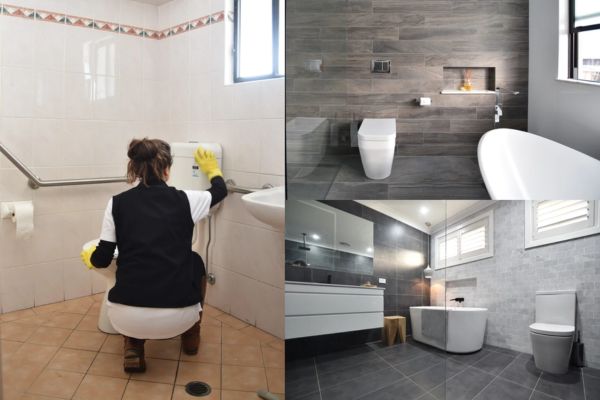Introduction
The Importance of a Clean Bathroom
Adopting clean bathroom tips is crucial for more than just aesthetics; it’s a vital aspect of maintaining a healthy living environment. Bathrooms, prone to germs, bacteria, and fungi due to moisture, require regular cleaning and proper hygiene practices. These clean bathroom tips are essential to prevent the spread of illnesses and ensure household well-being. Furthermore, a well-maintained bathroom enhances the overall comfort and ambiance of your home, creating a more pleasant and relaxing space.
Overview of Tips and Tricks
In this article, we’ll delve into a range of clean bathroom tips to keep your space both sparkling and hygienic. Covering everything from daily cleaning habits to weekly deep cleaning routines, we ensure no stone is left unturned. These clean bathroom tips will also guide you in creating and using natural cleaning solutions, organizing and decluttering your area, preventing mold and mildew, and maintaining your cleaning tools effectively. Whether tackling hard water stains or seeking eco-friendly options, this guide offers practical advice for every bathroom cleaning challenge.
Daily Cleaning Habits
Wiping Surfaces Regularly
To maintain a hygienic bathroom, a vital clean bathroom tip is to develop the habit of wiping down surfaces daily. This includes the sink, countertops, and faucet handles. Utilizing a disinfectant wipe or a cloth with a mild cleaning solution is effective in quickly removing toothpaste splatters, soap scum, and water spots. Such small daily efforts, part of essential clean bathroom tips, prevent the buildup of grime and bacteria, making your weekly deep cleaning sessions much more manageable.
Managing Moisture and Ventilation
Moisture control is key in a bathroom environment. After showers or baths, make it a routine to open a window or use an exhaust fan to reduce humidity levels. This practice not only helps in preventing mold and mildew but also maintains a fresher atmosphere. Additionally, consider using a squeegee to wipe down shower walls and doors. This simple action can significantly reduce water spots and soap residue, keeping the area cleaner for longer.
Weekly Deep Cleaning Techniques
Scrubbing the Toilet, Sink, and Bathtub
A weekly deep clean is essential for maintaining a sanitary bathroom. Start with the toilet, using a dedicated brush and a disinfectant cleaner to thoroughly scrub both the bowl and the outer surfaces. Don’t overlook areas like the base and the underside of the seat. For the sink and bathtub, use a non-abrasive cleaner to tackle soap scum and water stains. Pay special attention to drains and faucets, where grime can accumulate. These tasks, though time-consuming, are crucial for eliminating germs and maintaining a sparkling bathroom.
Cleaning Mirrors and Glass Surfaces
Mirrors and glass surfaces are prone to smudges and watermarks. Use a streak-free glass cleaner and a microfiber cloth for a clear, shining finish. For best results, spray the cleaner onto the cloth rather than directly onto the glass to avoid drips and overspray. This method also ensures a more even application and reduces waste. Remember, a clean mirror can significantly enhance the overall appearance of your bathroom.
Natural Cleaning Solutions
Homemade Cleaners: Vinegar, Baking Soda, and More
Embracing natural cleaning solutions not only benefits the environment but also ensures a safe and non-toxic atmosphere in your bathroom. Common household items like vinegar and baking soda can be powerful cleaning agents. For instance, a mixture of vinegar and water makes an excellent solution for removing soap scum and hard water stains. Baking soda, when used as a paste, can effectively clean grout lines and surfaces without scratching. These natural cleaners are not only cost-effective but also reduce the chemical load in your home.
Eco-Friendly and Safe Cleaning Practices
Incorporating eco-friendly practices into your bathroom cleaning routine is not just good for the planet, but it also safeguards your health. When using natural cleaners, it’s important to ventilate the area well, as some natural substances can have strong odors. Additionally, always label homemade cleaning solutions clearly, and store them safely away from children and pets. By choosing natural and safe cleaning methods, you contribute to a healthier home and a cleaner environment.
Organizing and Decluttering
Effective Storage Solutions
A clutter-free bathroom is easier to clean and maintain. Begin by evaluating your storage needs and making the most of the available space. Utilize shelving, drawer organizers, and shower caddies to keep items off the counters. Assign a specific place for each item, whether it’s toiletries, cleaning supplies, or towels. This organization not only simplifies the cleaning process but also creates a more serene and functional bathroom environment.
Minimizing Clutter for Easier Cleaning
Regularly decluttering your bathroom is key to maintaining its cleanliness. Periodically go through your cabinets and drawers to remove expired products, unused items, or excess clutter. This practice not only frees up space but also reduces the number of surfaces where dust and grime can accumulate. A minimalist approach to what you keep in your bathroom can significantly streamline your cleaning routine, making it quicker and more efficient.
Preventing Mold and Mildew
Identifying Problem Areas
Mold and mildew thrive in damp, warm environments, making bathrooms a common hotspot. Regularly inspect areas like shower corners, curtain liners, and under the sink for any signs of mold or mildew growth. Pay special attention to tile grout, sealants, and any other areas where moisture tends to accumulate. Early detection is key to preventing the spread and making cleaning efforts more manageable.
Natural and Chemical Preventive Measures
Once you’ve identified potential problem areas, it’s essential to take preventive measures. For a natural approach, consider using a solution of vinegar and water as a regular spray to inhibit mold growth. For more persistent problems, you may need to use a stronger, chemical-based mold and mildew remover. Always ensure proper ventilation when using these products. Additionally, maintaining low humidity levels in your bathroom by using an exhaust fan or dehumidifier can significantly reduce the likelihood of mold and mildew development.
Sanitizing Tools and Accessories
Cleaning Brushes, Mops, and Sponges
The tools you use to clean your bathroom need regular cleaning and sanitization themselves. After each use, thoroughly rinse brushes, mops, and sponges to remove any debris or cleaner residue. Periodically soak these tools in a disinfectant solution or a mixture of bleach and water to kill bacteria and fungi. Allow them to dry completely before storing to prevent the growth of mold and bacteria. This not only extends the life of your cleaning tools but also ensures they are hygienic for each use.
When to Replace Cleaning Tools
It’s important to recognize when it’s time to replace your cleaning tools. Over time, brushes and sponges can become worn out and less effective. Look for signs of fraying, bad odors, or persistent stains as indicators that it’s time for a replacement. Regularly replacing these tools ensures that your cleaning efforts are as effective and hygienic as possible. As a general rule, consider replacing sponges every two to three weeks and brushes every few months, depending on their condition and frequency of use.
Special Considerations
Handling Hard Water Stains
Hard water stains can be a persistent issue in many bathrooms. These are typically caused by minerals in the water that leave deposits on surfaces. To tackle hard water stains, use cleaners specifically designed for them, or create a paste of vinegar and baking soda for a natural solution. Apply the cleaner, let it sit for a few minutes to break down the deposits, and then scrub gently. For faucets and showerheads, consider using a bag filled with vinegar tied around the fixture overnight to dissolve mineral buildup.
Safe Disposal of Cleaning Products
When disposing of cleaning products, especially those that are chemical-based, it’s important to do so responsibly. Avoid pouring chemicals down the drain as they can harm the water supply and the environment. Check your local waste management guidelines for the proper disposal of household chemicals. Some areas have specific facilities for hazardous waste. Additionally, consider transitioning to eco-friendly and biodegradable cleaning products to minimize environmental impact.
Conclusion
Recap of Key Tips
Maintaining a clean and hygienic bathroom is a continuous process that requires regular attention. We’ve covered essential tips like establishing daily and weekly cleaning routines, using natural and eco-friendly cleaning solutions, and organizing your space to make cleaning more manageable. Remember, preventing mold and mildew is as important as cleaning surfaces, and taking care of your cleaning tools ensures their effectiveness and longevity. Tackling special challenges like hard water stains and responsibly disposing of cleaning products are also crucial for a holistic approach to bathroom maintenance.
Maintaining Hygiene Long-Term
The key to maintaining a hygienic bathroom lies in consistency and adaptability. By incorporating these tips and tricks into your regular routine, you’ll not only keep your bathroom looking clean and fresh but also create a healthier environment for yourself and your family. Regular maintenance, along with a mindful approach to the products and methods you use, will ensure that your bathroom remains a clean and inviting space in your home.


